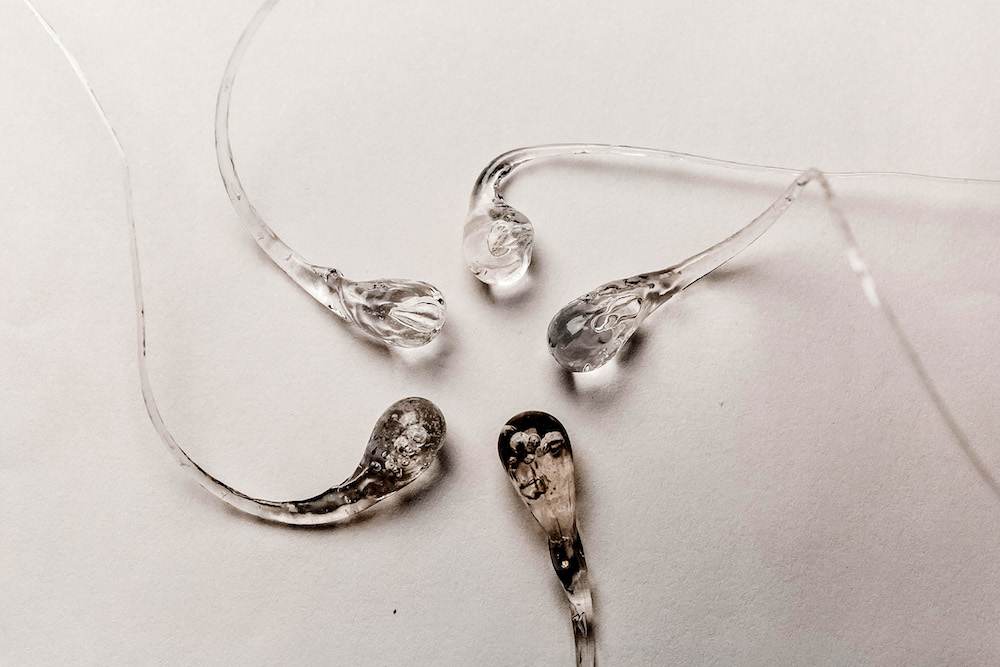Editor's Note: This story was updated at 1:30 p.m. E.T.
The mystery of tiny teardrop-shaped glass confections that can survive a hammer blow, yet shatter to smithereens with the slightest touch to the stem, has finally been solved.
The strange shapes, called Prince Rupert's drops, have posed a riddle that has stymied scientists for 400 years.
"On one hand, the head can withstand hammering, and on the other hand, the tail can be broken with just the slightest finger pressure, and within a few microseconds the entire thing shatters into fine powder with an accompanying sharp popping noise," study co-author Srinivasan Chandrasekar, a professor of industrial engineering and director of the Center for Materials Processing and Tribology at Purdue University in Indiana, said in a statement.
Now, a new study reveals that the head of these little glass tadpoles has such indomitable strength because of the compressive forces acting on the outside of the drops. These forces rival the compressive forces in some forms of steel, the study found. [The Mysterious Physics of 7 Everyday Things]
Glass curiosities
Prince Rupert's drops first gained widespread fame in 1660, when Prince Rupert of the Rhine (of Germany) brought a few of the curiosities to King Charles II of England. (The teardrops, which are made by pouring molten glass into cold water, had likely been known to glassblowers centuries earlier.) Charles then handed them over to the Royal Society, which published its first scholarly investigation of their properties in 1661.

Over the centuries, scientists puzzled over the riddle of Prince Rupert's drops. In 1994, Chandrasekar and a colleague used a high-speed camera to capture 1 million frames per second of the drops as they shattered. The footage revealed that tiny cracks that form in the tail rapidly spread into the head.
Sign up for the Live Science daily newsletter now
Get the world’s most fascinating discoveries delivered straight to your inbox.
Once those cracks reach high enough speeds (about 1.5 kilometers per second), they split in two, Chandrasekhar said. Then those two cracks reach a high enough speed and split in two, and so forth. Eventually, the entire structure is completely overtaken by myriad tiny cracks, he said.
"The tail will snap off but the head will explode into powder, and that part is actually quite spectacular," Chandrasekhar told Live Science.
That finding explained why the tail's snapping destroys the structure so easily. However, since that investigation, scientists have tried to explain these glass baubles' paradoxical combination of strength and fragility, but have never come up with a satisfactory explanation of the head's nearly shatterproof properties. [The 18 Biggest Unsolved Mysteries in Physics]
Strong head
In the new study, Chandrasekar relied on a slightly different technique called integrated photoelasticity, to reveal the mysteries of the glass tadpoles' heads. The technique calls for placing the object in a pool of water and then passing polarized light waves, or light that is oriented in a single plane, through the material. Internal stresses inside the material change the polarization of the light. Looking at the polarization of the outgoing light waves through special filters reveals the internal stresses inside the object — in this case, the head of the drop and the tail.
It turned out that the heads of the Prince Rupert's drops sustained extraordinary levels of compressive stress — about 50 tons per square inch. (Compressive stress is the force per unit area that squishes things together).
These stresses formed because the type of glass used in these teardrops — which expands dramatically with heat — also shrinks dramatically when exposed to cold water. During the process to make these drops, the molten glass is dipped in cold water. When the glass hits the water, the outside cools faster than the inside. The outside layer of the glass then forms a kind of "jacket" that squishes the inside. Because the inside is still cooling, and because the total forces acting in the object have to equal zero, the head forms tensile stresses on its interior, the researchers reported in their paper, which was published online in Applied Physics Letters. (In general terms, tensile stress is the internal force per unit area that pulls things apart – think of the act of tearing a piece of paper in half. Tensile and compressive stresses act in opposite directions and so cancel each other out.)
The reason the compressive stress on the outside of the drops prevents fracturing is somewhat intuitive; the compression is squishing the atoms of the glass closer together – so they have no place to go. Fractures also don't move as easily through materials under compression. By contrast, most materials tend to break more easily when they are being pulled apart in tension.
However, even these shatter-resistent confections will eventually crack under pressure; for instance, if the heads of the drops are put inside a vise with enough pressure, they too will eventually turn to powder, though not quite as spectacularly as in the tail-snapping process, Chandrasekar said.
"Nothing is unbreakable," Chandrasekar said.
Editor's Note: This story was updated to clarify in one instance that compressive stress is the force per unit area, not the force, acting inside an object.
Originally published on Live Science.

Tia is the managing editor and was previously a senior writer for Live Science. Her work has appeared in Scientific American, Wired.com and other outlets. She holds a master's degree in bioengineering from the University of Washington, a graduate certificate in science writing from UC Santa Cruz and a bachelor's degree in mechanical engineering from the University of Texas at Austin. Tia was part of a team at the Milwaukee Journal Sentinel that published the Empty Cradles series on preterm births, which won multiple awards, including the 2012 Casey Medal for Meritorious Journalism.










